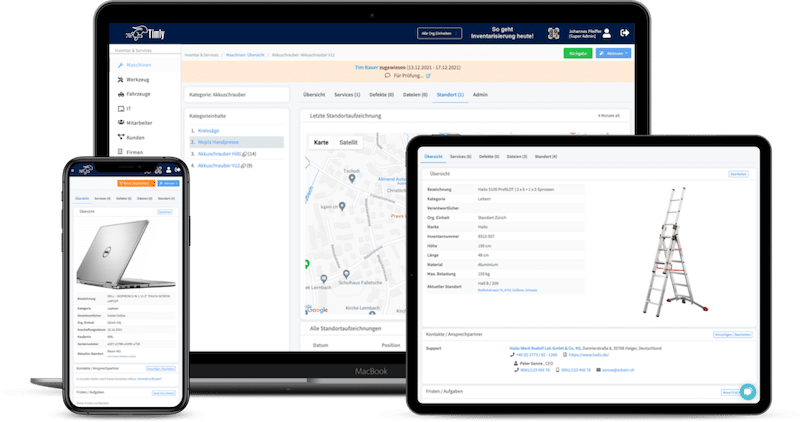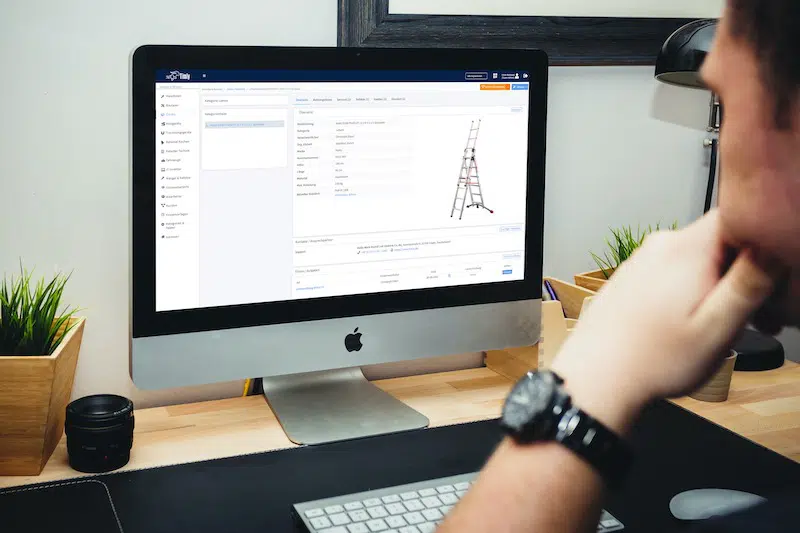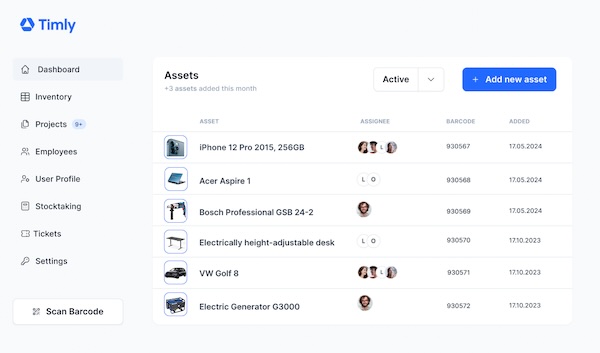8 Best Practices for the Safe Use of Step Ladders and Ladders
In this article:
- How to use a step ladder: Making manual handling safer
- Safe use of ladders checklist for working at heights
- Where can I find essential guidance for the safe use of step ladders?
- Equipment maintenance for safe use of ladders and step ladders
- HSE UK: Creating transparent instructions for workplace safety
- Using digitised asset management, training, and tracking software
- How asset management software can improve workplace safety
- Handling guidelines for ladders and step ladders without red tape

Working at height comes with inherent risks, but these can be mitigated through best practices.
How to use a step ladder: Making manual handling safer
Is your innovative business built on outdated basics? Is something as simple as the safe use of step ladders going to cause regulatory issues in the workplace?
Nobody wants to be the target of a health and safety violation complaint.
The guidelines for the safe use of step ladders share two things in common with other workplace safety regulations: they’re easy to overlook and they’re crucial every single day.
In the annual statistics of the German Statutory Accident Insurance, ladder use is among the three most common accident focal points in the category of structural installations – and they account for around 8% of non-fatal injuries in UK studies (HSE Ladder Guidance: Ladders Association).
Today, we’re getting ahead of these problems and streamlining the guidelines for the safe use of ladders – with asset management as your unexpected ally in this process, saving you 1,000s of man-hours on compliance training, troubleshooting, and health and safety work!
There is always risk associated with the use of step ladders – this is the of any approach to safe use. The UK Health and Safety Executive (HSE UK) notes that they are low risk, but it is the management of equipment and human factors that manage risk.
Safe use of ladders checklist for working at heights
If ever in doubt, here are 5 hallmark decisions you need to review – a simple “safe use of step ladders checklist”:
Why: Obviously, ladders pose a risk because they may slip, they may fall, and this puts the wellbeing of workers at risk. Ladders are one of the most common sources of workplace injury – especially when poor equipment maintenance, risk assessment, or human error are involved.
What: Ladders must be in proper, safe working condition before use. This is a matter of regulation compliance and risk management for employer-organisations before use begins. This is one of the most important legal provisions that organisations are responsible for and – with Timly – asset and equipment management is easy.
When: A step ladder should be a secondary choice when working at heights because they have very little fall protection and should not be used for over 30 minutes due to fatigue-based human risks. Ladders should be used after risk assessment and comparison to alternatives (such as dead or mobile elevating work platforms) have been considered.
Where: Step ladders should be reserved for flat, stable, even surfaces which do not offer high risk of slipping. With leaning ladders, install a strong upper resting point, high enough for the task and to face the work activity without using the top three rungs. Otherwise use an effective stability device for added security.
Who: A competent, trained, and experienced team member should use the ladder or supervise use of the step ladder. Appropriate workwear (e.g. a helmet) should be used to reduce risk further during heavy manual handling.
These provide a simple criteria to check the suitability of a personnel-equipment-task operation for safely working at heights. Having a clear idea of these key factors gives you operational safety confidence.
Over 600 Companies, Schools and Cities Rely on Timly
Where can I find essential guidance for the safe use of step ladders?
The specific configuration of guidelines for the safe use of step ladders should be based on the regulations of the Health and Safety Executive – specifically, Ladders Association LA455, ‘Safe Use Of Ladders and Stepladders’.
This document contains comprehensive guidance on the practical use of ladders in a commercial environment. These concern the criteria for suitable products and the permissibility of use – for example, working heights, necessary safety measures, time limits, risk assessment, and more.
This is your main education resource for understanding health and safety training for the safe use of ladders and step ladders.
Equipment maintenance for safe use of ladders and step ladders
It’s impossible to do safe work on unsafe equipment: improper maintenance, selection, storage, setup, and training all contribute unnecessary levels of risk to the workplace where employees may be unfairly injured – and which costs UK companies millions of pounds every year in compensation.
Avoiding this issue is simple. Ladders and step ladders should be stored, logged, and repaired with the same kind of urgency as more complex equipment – such as bulk lifters or trucks.
Taking ladder maintenance and use seriously both keeps employees safe and provides companies with the proper legal protection of following compliance requirements. These include the stiles and feet, rung stability, hinge and locking mechanism function, and platform useability.
The Ladder Association and HSE ladder guidance suggests that multiple rounds of checks should be implemented during use:
1. The user should check it, thoroughly, prior to use
2. A check at the beginning of the workday
3. At any time something changes: use of the ladder, change of locations, or cleaning.
This kind of compliance documentation can easily be loaded into Timly to ensure proper digital documentation. That means no more digging through files and folders in the office – it’s easy to get the condition of equipment at a glance, including inspection and repair history.
We believe this is one of the most simple but useful implementations of software in proper, professional health and safety compliance. It’s far easier to fit into your budget than a compensation claim!

Timly’s software explained in under 2 minutes

Equip your employees with safety guidelines using Timly 360° Asset Management Tool.
(No credit card required)
HSE UK: Creating transparent instructions for workplace safety
Once equipment is in proper condition, it’s essential to ensure that the human element of using ladders and step ladders is equally well considered. Proper training is a cornerstone of safe equipment use – whether that’s an HGV or a step ladder.
This training is not extensive, but it does make the difference between safety and risk for your valued employees. These include ladder safety essentials like:
• Proper angles for setting up a ladder (4:1 ratios)
• Keeping the navel within the stiles during work (easy tip: to avoid overreach make sure your belt buckle is within the uprights of the ladder)
• Maintaining 3 points of contact with the ladder
• To only carry light materials and tools read the manufacturer
• How to secure a ladder to a wall / using stand-off devices to prevent tipping over (e.g. by tying a ladder secure strap for added stability)
• 2-person ladder use for safety
• How to properly check equipment condition and usability
• Proper use of telescopic ladders, step ladders, and other types of ladder
This is outlined in the LA455, ‘Safe Use Of Ladders and Step Ladders’, a type of documentation that can be uploaded to Timly’s asset management software as part of the training package for your employees.
Flexible asset profile design – adapting to your moment-to-moment needs – allows you to make this process easy and seamless. It can be as easy as automating training materials to employees once they check out a piece of equipment – like a telescopic ladder.
This kind of dedicated and adaptive infrastructure solves health and safety compliance issues and equipment monitoring at the same time. You can also automate the delivery of training materials to employees once they check out a piece of equipment – and centrally update these materials in real time to keep up with changes to regulations and your equipment!
This kind of transparency is central to an effective health and safety regulatory role, and safeguards both employees and the organisation itself. This win-win is easy when you have proper training protocols, and an easy, digital option for sharing them with employees.
Using digitised asset management, training, and tracking software
Timly is a flexible asset management software that easily adapts to your work needs, can save 10,000s of hours a year, and streamlines the management of your organisation’s stock, people, and documents.
The idea is beautifully simple: cloud-based SaaS that makes the back end of inventory, personnel, and document management easy. It lets you manage every aspect of your assets, training and documentation, personnel profiles (their qualifications, training status, etc.), and automations based on your organisation’s needs.
Equipment and training materials are just one kind of asset that Timly manages easily and intuitively. Maybe its furniture, a vehicle, ladders, whatever. The flexibility of the software lets you build low-input, high-output systems for your assets that save time, effort, and human errors!
Optimised for easy smartphone and tablet use, including an easy web inventory app, Timly experts guarantee data security, compliant with GDPR regulations, right out of the box. It also makes things easier for users, keeping your employees happy.
One function of Timly you’ll love is QR management. Attach QR codes to assets to let employees use one scan logging, allocating assets to their profile for tracking and document automation, without any front-end human input.
In addition to the guidelines for ladders, companies often contend with rapidly evolving regulations. Update centrally and Timly automatically updates to the digital personnel file, letting you update for compliance once – whether you have 2 employees or 20,000.
It’s a centralised platform, giving managers easy oversight of their material and human resources, can be easily accessed from any web-connected device, and offers a single terminal for every item and intellectual property asset in your organisation!
How asset management software can improve workplace safety
Timly addresses several issues with its inventory software. Inspection dates can be stored in the maintenance planner, and the guidelines for ladders and step ladders in the profile of the work equipment. Training management facilitates the systematic instruction of all affected employees.
Asset management software allows managers to remotely confirm the location, status, and allocation of ladders and step ladders. The easy automation of training materials also ensures that employees always know what to do – and they know where to look if they’re uncertain in the field.
Handling guidelines for ladders and step ladders without red tape
To make it even simpler, with Timly, you can provide direct reference materials to the compliance guidelines. You can confirm QR checks of proper safety equipment (e.g. stand-offs and helmets with ladders) so you know everything is in the right place, with the right person, with the right training.

Timly’s software makes it possible to manage inventory and assets at any time and from anywhere
Recommended for you:
Book an online demo - free and without obligation - or create your free trial account directly.





